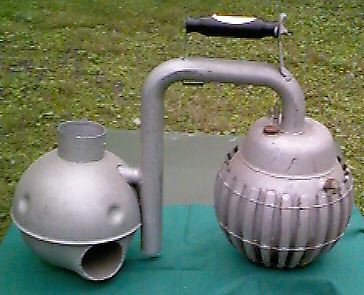I’ve been trying to decide what to do with the sunlight I plan to collect. While searching for inspiration I came across the IcyBall, an early refrigeration unit that is powered by heat.
(image from Crosley Automobile Club)
This ingenious device was developed simultaneously in North America and Australia and sold during the 1920s and 30s. The above unit is the American design from Powel Crosley, below is the Australian design by Edward Hallstrom – I love the comparison.
(image from Wikipedia)
Both Icyballs (although there is some dispute as to whether the Australian version was actually called an IcyBall) are heat absorption refrigerators that run on kerosene.
A water/ammonia mixture is heated in a pressurised chamber for about 90 minutes (the chamber on the right in the above image) causing the ammonia to evaporate out of the water due to its lower boiling point. The ammonia then condenses in the ‘cold’ side of the system leaving the water in the ‘hot’ side. This process is called ‘charging’ the system. When the unit is fully charged the heat source is removed and the cold ball is placed in an insulated box (the refrigerated space). As the ammonia evaporates to recombine with the water it absorbs heat, cooling the inside of the refrigerator for up to 24 hours.
DIY IcyBall in operation. Made by Larry Hall
There’s something magical about this process – turning heat into cold – and the IcyBall still has fans (particularly in the ‘run-to-the-hills-the-world-is-going-to-end’ community). By all accounts it’s a very cool design, there are IcyBalls out there that are still operating 85 years after manufacture. I contemplated making my own for the ACCA show – what a great use of the solar energy I plan to collect – but the more I investigate the less convinced I am by the idea.
Firstly, there’s a LOTS OF WARNINGS IN CAPITAL LETTERS about how ammonia can explode and kill you, and in some cases actual accounts of this happening (such as with this absorption refrigerator designed by Albert Einstein and Leó Szilárd). Secondly, there are many recent projects that have taken the absorption refrigeration idea and redeveloped it, often as a solution for the developing world (see for example these projects from San Jose State University, Humboldt State University, and this exciting but seemingly now defunct project from Adam Grosser). These projects, often university based research, are impressive but they highlight the complexity of developing a working absorption refrigeration system and they make it clear that this is probably not a 3 month art project. Another time perhaps.




